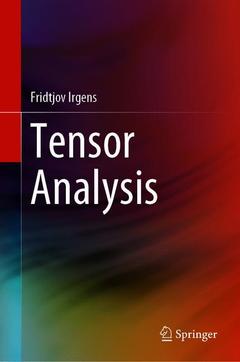Description
Tensor Analysis, 1st ed. 2019
Author: Irgens Fridtjov
Language: English
Subject for Tensor Analysis:
Support: Print on demand
Description
/li>Contents
/li>Biography
/li>Comment
/li>
This book presents tensors and tensor analysis as primary mathematical tools for engineering and engineering science students and researchers. The discussion is based on the concepts of vectors and vector analysis in three-dimensional Euclidean space, and although it takes the subject matter to an advanced level, the book starts with elementary geometrical vector algebra so that it is suitable as a first introduction to tensors and tensor analysis. Each chapter includes a number of problems for readers to solve, and solutions are provided in an Appendix at the end of the text.
Chapter 1 introduces the necessary mathematical foundations for the chapters that follow, while Chapter 2 presents the equations of motions for bodies of continuous material. Chapter 3 offers a general definition of tensors and tensor fields in three-dimensional Euclidean space. Chapter 4 discusses a new family of tensors related to the deformation of continuous material. Chapter 5 then addresses constitutive equations for elastic materials and viscous fluids, which are presented as tensor equations relating the tensor concept of stress to the tensors describing deformation, rate of deformation and rotation. Chapter 6 investigates general coordinate systems in three-dimensional Euclidean space and Chapter 7 shows how the tensor equations discussed in chapters 4 and 5 are presented in general coordinates. Chapter 8 describes surface geometry in three-dimensional Euclidean space, Chapter 9 includes the most common integral theorems in two- and three-dimensional Euclidean space applied in continuum mechanics and mathematical physics.The author is a Professor Emeritus at the Norwegian University of Science and Technology (NTNU). His major field of interest is continuum mechanics.
He obtained an M.Sc. degree in Theoretical and Applied Mechanics from Iowa State University in 1960, and completed a degree in Civil Engineering, majoring in Structural Engineering at NTNU in (1960) He started his academic carrier as an Assistant and Associate Professor in Mechanics at NTNU in 1963 and was appointed Professor in Solid Mechanics at NTNU in 2003. He has been a Visiting Professor at the University of Connecticut and University of Colorado.
He has been involved in a variety of projects in which fluids and fluid-like materials have been modeled as non-Newtonian fluids, such as avalanching snow, granular materials in landslides, extrusion of aluminium, modeling of biomaterials as bone, and viscoplastic modeling of paper to simulate the calendaring process. He is author or coauthor of 26 papers and 11 conference presentations on mechanics and biomechanics.
He has published the following textbooks in the Norwegian language: Statics, 7 editions; Strength of Materials, 7 editions; Dynamics, 4 editions; Continuum Mechanics; and Tensor Analysis. In 2008 his book Continuum Mechanics was published by Springer Verlag. In 2014 his book Rheology and Non-Newtonian Fluids was published by Springer Verlag.
At NTNU he has lectured on elementary and advanced topics in the entire field of theoretical and applied mechanics: engineering mechanic, dynamics, fluid mechanics, biomechanics, rheology, continuum mechanics and tensor analysis. For NTNU he has developed new courses in Continuum Mechanics, Tensor Analysis, Rheology and Non-Newtonian Fluids, and Biomechanics.
Presents tensors and tensor analysis as primary mathematical tools for engineering students and researchers
Includes problems for readers to solve as well as the solutions
Starts at the very beginning and takes the subject matter to an advanced level



